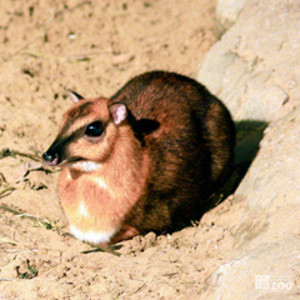Greater Malayan Chevrotain
[Tragulus napu]

The Greater Malayan Chevrotain is also known as a "mouse deer" and has head and body length of 20 to 24 inches. The animal can weigh from 9 to 13 pounds. Chevrotains have a reddish coat. They have a cumbersome build, with short thin legs and have limited agility. Males are smaller than females.
These small secretive creatures are most active at night. Like other ruminants, they have a four-chambered stomach. Their gut is modified for the fermentation of food. They lead a solitary lifestyle and have no horns or antlers. They are easy prey and an important source of food for many predators, including large snakes, crocodiles, eagles and forest-inhabiting cats. These animals are often referred to as mouse deer. The survival of this species depends on the conservation of their habitat and restriction of hunting.
Location: Animals Formerly at Zoo
Share:
Range
The range of the Greater Malayan Chevrotain is Southeastern Asia excluding Java.
Habitat
Greater Malayan Chevrotains live in Tropical Rainforests with a preference for rocky habitats.
Conservation Status
Least ConcernPrimary Threats
Human-Wildlife Co-Existence. Hunting and Habitat LossGestation
Gestation Greater Malayan Chevrotains is approximately 5 months.
Litter
Greater Chevrotain litters are from 1 to 2.
Behavior
Greater Malayan Chevrotains live either alone or in pairs and are mainly nocturnal.
Reproduction
Chevrotains can breed throughout the year. The active young are fully developed at birth, being capable of standing within 30 minutes. Sexual and physical maturity comes at about 5 months.
Wild Diet
Grass, leaves of low-bushes, and fruit.
